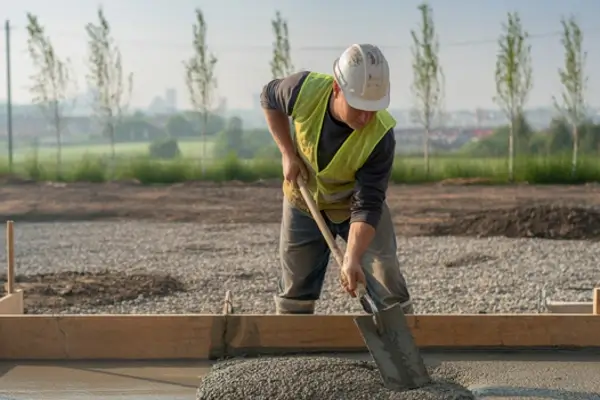Pumping, pouring and finishing concrete Risk Assessment

A comprehensive Risk Assessment for pumping, pouring and finishing concrete.
Pouring and finishing concrete is a critical process in construction that involves a series of meticulous steps to transform a mixture of wet concrete into structurally sound and aesthetically pleasing surfaces. This method is fundamental for diverse construction applications, including building foundations, flooring systems, roadways, sidewalks, and patios.
The concrete mix consists of cement, water, and aggregates, such as sand, gravel, or crushed stone, each selected to achieve the desired consistency, workability, and compressive strength. The precise ratios of these components are vital, as they directly influence the final quality of the concrete.
To shape the concrete structure, formwork—or moulds—are employed. These can be made from materials such as wood, metal, or plastic, and are crafted to the specific dimensions required for the project. Once the formwork is securely set up, the mixed concrete is poured into it, often facilitated by specialised equipment such as concrete trucks equipped with rotating drums or delivery chutes to ensure an efficient and uniform pour.
Following the pour, the concrete must be compacted to eliminate air pockets, which can compromise its integrity and strength. This is typically achieved using vibrating screeds or manual tampers, ensuring the mixture is evenly distributed and densely packed within the formwork.
After compaction, the surface of the concrete is leveled with precision. This is done using tools like screeds—a long, straight board that slides across the top of the formwork—to create an even plane. For a smoother finish, additional tools such as floats and trowels are employed. The choice of finishing tools depends on the desired surface texture, with options ranging from a smooth, polished look to a more textured appearance created by brooms or other finishing implements.
To ensure a neat and visually appealing edge, the perimeter of the concrete slab is often finished with a trim. This detail enhances the overall look and can significantly impact the durability of the edges, preventing flaking and chipping over time.
As the concrete cures, control joints may be strategically placed within the slab. These joints are essential for accommodating the natural shrinkage that occurs as the concrete hardens, effectively minimizing the risk of cracking that could otherwise compromise the structure’s stability.
Ultimately, proper curing techniques are crucial for realising the full potential of the concrete. This generally involves maintaining moisture through methods such as wet curing, where the surface is kept damp, or covering it with curing blankets, allowing the concrete to hydrate adequately and develop the necessary strength over time. Curing is a critical phase that often lasts several days or weeks, depending on environmental conditions and specific project requirements.
This document is:
- Recognised by local authorities
- Recognised by principal contractors
- Suitable for CDM sites
- Approved by H&S managers
It increases your chance of winning tenders and has been written by trained health and safety professionals.
If you want others to have confidence in your company, download and buy the proper documents today.
As with all our documents, our risk assessments are in Word™ format, available for instant download and use, and only need to be bought once.
Once you buy and download this document, it's yours to use repeatedly.
Download today's risk assessment, put your company details on it, and use it immediately.
Give people confidence in you, your company, your products and services.
Some sample text from this document reads:
'Cement
Irritating to the respiratory system and skin, and may cause chemical burns, risk of severe damage to eyes, may cause sensitisation by skin contact
• Avoid respirable dust using a mask, goggles, loading cement mixers, etc. By standing upwind of the product
• Any contaminated areas to be washed immediately with copious amounts of fresh water
• The use of barrier cream and latex gloves underneath gripper gloves is encouraged.'
This is an essential Risk Assessment for concrete works. If you work with concrete, control your risks with this assessment from HSEDocs.
Why not browse the HSEDocs catalogue of method statements, risk assessments, COSHH assessments, or industry-specific packages?
GET THIS DOCUMENT
£8.99+VAT
- Available in Word™
- Fully customisable
- Add your Company Logo
- UK & EU Compliant

 CART
CART 